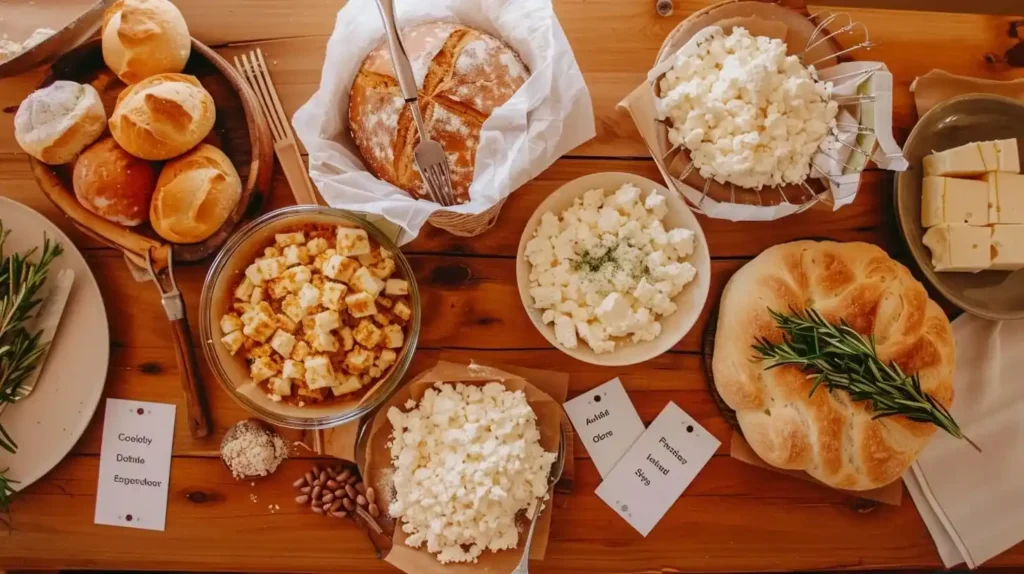My first encounter with cottage cheese in baking came during a summer visit to my grandmother’s Kentucky farm when I was nine. Watching her fold the lumpy white cheese into pancake batter, I couldn’t hide my skepticism. “Trust me,” she winked, noticing my wrinkled nose. “It’s my secret ingredient.” When those pancakes emerged fluffier and more tender than any I’d tasted, I became a believer. “What Does Cottage Cheese Do in Baking?” I asked, wide-eyed with culinary curiosity.
My grandmother smiled and explained that cottage cheese was her “magic ingredient” for everything from breakfast pancakes to dinner casseroles. “It adds moisture without thinning the batter, brings protein without changing the flavor, and creates a tenderness that nothing else can match,” she explained while letting me help mix her famous coffee cake.
Years later, as I teach my own children to bake, cottage cheese has become our family’s not-so-secret ingredient too. That lumpy cheese that many people only associate with diet plates turns out to be one of the most versatile, nutritious additions to baked goods—transforming ordinary recipes into moist, protein-rich treats without anyone detecting its presence.
Table of Contents
Why Understanding Cottage Cheese’s Baking Benefits Matters
Knowing what cottage cheese does in baking helps you create healthier, more delicious baked goods. Here’s why this knowledge is valuable:
- Nutritional improvement: Enhance protein content in baked goods without complicated ingredients.
- Texture mastery: Achieve moisture and tenderness that other ingredients can’t provide.
- Recipe versatility: Adapt and improve countless recipes with one simple addition.
- Dietary adaptability: Create lower-fat baked goods that maintain rich mouthfeel.
- Problem-solving: Fix common baking issues like dryness with a simple ingredient.
I’ve incorporated cottage cheese into many recipes, from my cottage cheese egg bake to pancakes and muffins. Understanding what cottage cheese does in baking has enhanced all my cozy breakfast recipes and helped prevent issues like why egg bakes turn rubbery by adding necessary moisture.
What Does Cottage Cheese Do in Baking?5 Incredible Benefits

1. Creates Unparalleled Moisture and Tenderness
The most remarkable benefit of cottage cheese in baking is the exceptional moisture it provides. Unlike liquid ingredients that can make batters runny, cottage cheese adds substantial moisture without altering the batter’s consistency.
“Notice how the crumb stays tender for days,” my mother would point out when serving her cottage cheese-enhanced coffee cake three days after baking. The protein structure of cottage cheese helps trap and retain moisture, preventing the dreaded dry-out that happens with many baked goods.
When making quick breads like banana or zucchini bread, I’ve found that replacing a quarter of the butter or oil with cottage cheese creates a product that stays fresh significantly longer. This is especially valuable for busy families preparing breakfast options ahead of time. My children never notice the cottage cheese—they just wonder why our muffins stay so deliciously moist all week.
2. Boosts Protein Content Significantly
What does cottage cheese do in baking from a nutritional perspective? It transforms ordinary carbohydrate-heavy baked goods into protein-enhanced treats that provide sustained energy.
My nutritionist sister explains it best: “A standard muffin might have 2-3 grams of protein, but adding cottage cheese can boost that to 7-8 grams—similar to adding an egg, but with different textural benefits.” This protein enhancement is particularly valuable in breakfast baked goods, creating more satisfying, energy-sustaining morning options.
For busy parents trying to get adequate nutrition into children before school, this simple addition makes every bite more nutritious. My son’s sports coach once commented on his sustained energy during morning practice, unaware that the secret was cottage cheese in his breakfast muffin.
3. Acts as a Fat Replacement Without Flavor Compromise
One of the most practical benefits of cottage cheese in baking is its ability to replace some or all of the fat in recipes without sacrificing flavor or texture—something other fat replacements (like applesauce) can’t always accomplish.
“Cottage cheese maintains the mouthfeel that makes baked goods satisfying,” my grandmother would explain. The creamy texture provides the sensation of richness that lower-fat baked goods often lack, while the proteins help maintain structural integrity.
In my family’s favorite coffee cake recipe, replacing half the butter with cottage cheese cuts nearly 15 grams of saturated fat from the recipe while preserving the tender crumb and buttery taste. Even my butter-loving husband can’t tell the difference, making this substitution one of my most-used healthy baking tricks for busy weekday mornings.
4. Improves Structure and Stability
What Does Cottage Cheese Do in Baking? The proteins in cottage cheese strengthen the matrix of baked goods, providing stability similar to adding extra eggs but with a different textural result.
My first cheesecake attempt at age fourteen was a disaster—a cracked, sunken mess. My grandmother suggested adding cottage cheese to my next attempt. “The proteins create a safety net,” she explained. The blended cottage cheese added structure that prevented sinking while maintaining a creaminess that was actually superior to my original recipe.
This structural improvement is particularly valuable in gluten-free baking, where conventional binding can be challenging. When my neighbor needed gluten-free options, I found that adding cottage cheese to gluten-free muffins helped them hold together beautifully instead of crumbling—a common problem with gluten-free baked goods.
5. Enhances Flavor Without Overwhelming
Perhaps the most surprising benefit of cottage cheese in baking is its flavor neutrality combined with flavor enhancement. Once baked, cottage cheese loses its distinctive taste but amplifies the flavor of other ingredients through its umami properties.
“It’s like turning up the volume on your other ingredients,” my mother would say when adding cottage cheese to her famous blueberry muffins. The slight tang (similar to sour cream but milder) enhances sweetness without adding more sugar, while the creamy elements carry flavor compounds more effectively to your taste buds.
In chocolate recipes, I’ve discovered that cottage cheese intensifies the chocolate flavor—allowing me to use less chocolate for the same impact. This flavor enhancement without flavor intrusion makes it an incredibly versatile baking addition that works in everything from subtle vanilla cakes to boldly spiced carrot bread.
Best Practices for Using Cottage Cheese in Baking
To maximize What Does Cottage Cheese Do in Baking?, consider these practical tips:
For smooth texture: Blend cottage cheese in a food processor or blender before adding to batters if you want to eliminate the curds. For rustic baked goods like muffins, leaving small curds can add pleasant textural contrast.
For proper measurement: Drain excess liquid if your cottage cheese seems very wet, as brands vary in moisture content. This ensures consistent results across different brands.
For flavor balance: Reduce salt slightly in recipes when adding cottage cheese, as it contains some sodium that contributes to the overall seasoning.
Answers to Your Cottage Cheese Baking Questions
Q: Can I use low-fat cottage cheese in baking?
Absolutely! In fact, low-fat and nonfat versions often work better in baking than full-fat cottage cheese because their higher protein-to-fat ratio provides better structure. My grandmother used whatever was available, but I typically use 1% or 2% cottage cheese in most baking applications.
Q: Will the cottage cheese curds be visible in my baked goods?
Only if you want them to be. For completely smooth results, blend the cottage cheese before adding it to your batter. For recipes where texture doesn’t matter as much, like rustic muffins or pancakes, simply mash with a fork. My children have never once noticed the curds in my blended cottage cheese baking recipes.
Q: How much cottage cheese should I add to recipes that don’t call for it?
Start by replacing 25% of the fat (butter or oil) with an equal volume of cottage cheese. Alternatively, add ¼ cup cottage cheese to any quick bread or muffin recipe to enhance moisture without other adjustments. My mother’s rule of thumb was “a quarter cup never hurts” for standard-sized recipes.
Transforming Your Baking with Cottage Cheese
Understanding what cottage cheese does in baking opens up a world of possibilities for creating healthier, moister, more protein-rich baked goods without sacrificing flavor or texture. From quick breads to pancakes, muffins to coffee cakes, this humble ingredient creates remarkable improvements in both nutrition and eating quality.
When I bake with my children now, folding cottage cheese into our favorite recipes, I’m passing down more than just recipes—I’m sharing my grandmother’s wisdom about transforming simple ingredients into something special. Her practical farm kitchen ingenuity lives on in these techniques, connecting generations through the simple magic of cottage cheese in baking.
I hope you’ll experiment with this versatile ingredient in your own kitchen. What recipes will you enhance with cottage cheese’s remarkable benefits?
With warmth, Sophia

Cottage Cheese Blueberry Muffins
Ingredients
- 1½ cups all-purpose flour
- ½ cup whole wheat flour (or use all white flour)
- 2½ teaspoons baking powde
- ½ teaspoon baking soda
- ½ teaspoon salt
- ½ teaspoon cinnamon
- ⅔ cup granulated sugar
- ¾ cup cottage cheese (1% or 2% works best)
- ¼ cup butter, melted (or neutral oil)
- 2 large eggs
- 1 teaspoon vanilla extract
- ¼ cup milk
- 1½ cups fresh or frozen blueberries (if frozen, do not thaw)
- 2 tablespoons coarse sugar for topping (optional)
Instructions
- Preheat your oven to 375°F (190°C). Line a 12-cup muffin tin with paper liners or grease well.
- In a food processor or blender, process the cottage cheese until smooth, about 30 seconds.
- In a large bowl, whisk together the all-purpose flour, whole wheat flour, baking powder, baking soda, salt, and cinnamon.
- In a separate bowl, whisk together the granulated sugar, processed cottage cheese, melted butter, eggs, vanilla, and milk until well combined.
- Pour the wet ingredients into the dry ingredients and gently fold together until just combined. The batter should be thick and a few streaks of flour are fine.
- Gently fold in the blueberries, being careful not to overmix or break them.
- Divide the batter evenly among the muffin cups. They will be quite full. Sprinkle with coarse sugar if using.
- Bake for 20-24 minutes until the tops are golden and a toothpick inserted in the center comes out with a few moist crumbs.
- Allow to cool in the pan for 10 minutes, then transfer to a wire rack to cool completely.

